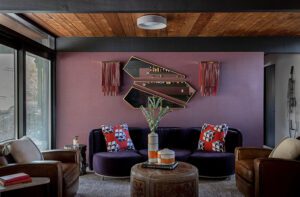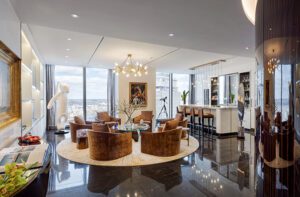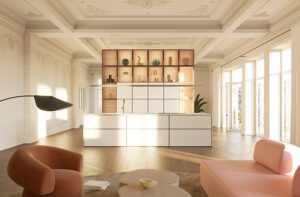In Stitches
June 18, 2014
From his chic urban loft in Providence, Michael Savoia embroiders luxury textiles to furnish the interiors of our country’s most sophisticated residences.
Text by Julie Dugdale
Michael Savoia holds up a swath of linen embroidered with an array of silvery patterns. When he shifts the material slightly, the thread catches the light pouring in from the wall-to-wall windows of his loft in downtown Providence. The embroidery takes on an iridescent, three-dimensional quality. The effect is elegant—the result of a technique that overlays two thread colors to add depth and interest to the pattern. “That gives embroidery motion,” Savoia says. “It plays with light. You actually see it differently as you walk around. It’s not static anymore.”
It’s these nuanced observations that make Savoia a sought-after craftsman in the field of textile embroidery. His clients are largely high-end designers who seek custom fabrics for furniture, curtains, and pillows. In fact, the throw pillows on the sofa in the Oval Office of the White House (they’ll eventually end up in the Smithsonian) are Savoia’s handiwork, commissioned by renowned interior designer Michael S. Smith. Savoia’s current projects include furnishings for a San Francisco home for interior designer Heather Hilliard and a collaboration with Sandra Jordan, purveyor of luxury alpaca textiles.
Although his clients are all over the country, Savoia works mainly out of his airy urban loft, which doubles as a studio. Fabric swatches, design sketches, and toss pillows are strewn about tabletops and counters. Giant rolls of his own line of linens from Ireland and Belgium are stacked near a wall mounted with spools of thread in every shade imaginable. And a chest-high, spool-loaded contraption that resembles a piece of medical equipment—a computerized embroidery machine—stands sentinel in the center of it all.
So how does a vision go from a sketch to the fabric? By manipulating a special embroidery software program on his computer, Savoia can experiment with colors, textures, and shapes to create a digital representation of the embroidery. He saves the design on a flash drive and transfers it to the embroidery machine. The machine reads the data and begins stitching on autopilot, one needle at a time. One design could take several hours or a day, depending on its intricacy. “The program is so full of tools that one can use creatively,” Savoia says. “You articulate the decision-making process you have in your mind through the tools of the software.”
He calls his style “traditional with a twist—maybe modern-primitive,” noting that he’s inspired by history, nature, antiques, and architecture. It’s not uncommon for him to wander streets and buildings, camera in hand, to capture interesting imagery. For example, he has created designs based on the bronze trim of the ticket windows of Grand Central Station in New York City, and stitched a pattern that mimics the domed ceiling of the National Gallery in Washington, D.C. “Nothing is new; what’s new is what we do with it,” he says. “I spend a lot of time in museums. I love to look at details in clothing—Renaissance clothing from England, Italy, and France. I love New York because of its art deco references.”
The historic streets of Providence make an ideal backdrop for architectural inspiration—more so, perhaps, than Los Angeles, where Savoia spent twenty-seven years before relocating in 2011 to teach computerized embroidery at the Rhode Island School of Design. Armed with a degree in art education, a master’s in art and textile design, and sales experience at the Donghia showroom in Chicago and the Mimi London showroom in Los Angeles, Savoia jumped at the opportunity to instruct young textile students in his niche craft. He says teaching at RISD has helped him to “look at the world with a different viewpoint; to start imagining in a new way.”
Savoia’s recent experimentation with real gold-leaf embroidery brings a whole new element to his designs. He starts by stitching the outline of a circle, then uses textile glue to apply the delicate, papery gold leaf inside the circle. Once it dries, he embroiders spiral stitches on top of the gold leaf for a subtle, shimmering, metallic effect. He isn’t sure where he’ll apply the technique, but he’s already envisioning the possibilities. “This would be wild in a hem—amazing,” he says, eyeing one of his sample gold-leaf patterns. “You go on a journey every time you start a design.” •
Villa Savoia, Providence, (401) 277-9900, villasavoiainc.com
Share
![NEH-Logo_Black[1] NEH-Logo_Black[1]](https://www.nehomemag.com/wp-content/uploads/2022/08/NEH-Logo_Black1-300x162.jpg)



















You must be logged in to post a comment.